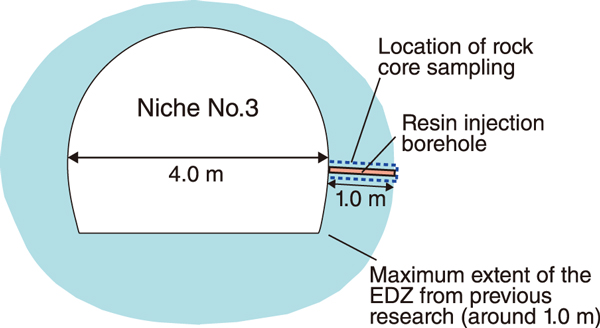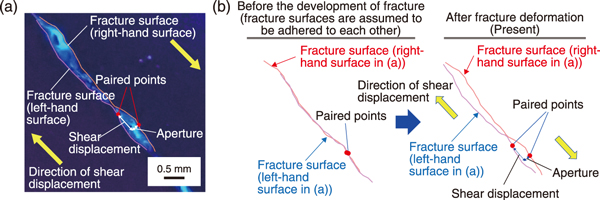
Fig.1 Extension of the excavation damaged zone (EDZ) around Niche No.3 and location of the resin injection borehole and rock core sampling

Fig.2 Photograph showing the distribution of resin-fixed fractures

Fig.3 Schematic of the shear displacement and fracture aperture measurement process

Fig.4 Relationship between shear displacement and aperture
During the construction of a high-level radioactive waste (HLW) disposal facility, the excavation may cause the development of numerous fractures around the access shaft, access gallery, and disposal gallery. These areas are called excavation damaged zones (EDZs). After the emplacement of vitrified wastes and backfilling the facility, the buffer material installed around the vitrified waste experiences swelling induced by groundwater penetration. This phenomenon causes deformation of the fractures in the EDZ (hereinafter, EDZ fractures) because of changes in the stress acting on the EDZ fracture. Thus, it is necessary to evaluate the effect of increase in the swelling pressure of the buffer material on the long-term permeability of the EDZ fracture to improve the reliability of the evaluation of radionuclide migration in the HLW disposal project.
Direct observation and measurement of the displacement of the EDZ fracture are effective for understanding the effects of increase in swelling pressure, but to the best of our knowledge, no studies have explored this topic. Toward this end, we injected a low-viscosity resin and fixed the EDZ fractures induced around Niche No.3 excavated at a depth of 350 m in the Horonobe Underground Research Laboratory (Fig.1). After the resin was polymerized, we acquired the rock core sample that contained the resin injection borehole and observed the development of the EDZ fractures under ultraviolet (UV) light (Fig.2). For measuring the displacement, we generated a profile of the fracture surface using a magnified photograph of the fractures (Fig.3(a)). The fracture displacement (aperture and shear displacement) were measured assuming that the fracture surfaces were joint before the fracture developed (left figure in Fig.3(b)), and then, the differential displacement was measured by considering the present fracture surface (right figure in Fig.3(b)).
The measurement results showed that the aperture of the EDZ fracture did not increase with an increase in shear displacement. Therefore, it is estimated that the permeability of the fracture will not be affected significantly even if the buffer material swells after the backfilling of the gallery, causing deformation of the EDZ fracture. This result can be applied to improve the reliability of the evaluation of migration behavior of radionuclides from vitrified waste. In addition, this result can be helpful for the design of hydraulic plugs that can be built at the entrance of a gallery to prevent groundwater flow and radionuclide migration through the galleries after the facility is backfilled.
This research was performed in collaboration with Kyoto University, “Visualization of Fractures in an Excavation Damaged Zone in the Horonobe Underground Research Laboratory.”
(Kazuhei Aoyagi)
<Previous: 9 Research and Development on Geological Disposal Technology | Next: 9-2>